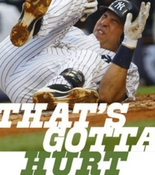Baseball players often have explanations for their struggles at the plate. Nagging injuries, recent slumps, difficulty in certain ballparks, and even superstitions are often cited. But John Hamilton has an unusual theory for his recent slump.
Hamilton blames his troubles on having blue eyes.
The Texas Rangers star and 2010 American League MVP believes that his blue eyes affect his hitting during the day. According to ESPNDallas.com, as of June 23, Hamilton was batting .122 with no home runs, 4 RBIs, and 17 strikeouts during the day. At night, he was hitting .374 with 6 home runs and 28 RBIs. During his MVP season, he batted .384 at night and .286 during the day.
Hamilton feels that his eye color affects his ability to see the ball. He told ESPN 103.3 FM’s Bryan Dolgin, “It’s just hard for me to see in the daytime. It’s just what it is. Try to go up squinting and see a white ball while the sun is shining right off the plate, you know, and beaming right up in your face.”

It is difficult to know if Hamilton’s blue eyes are truly the problem. Many MLB stars have had blue eyes with no known problems. Also, it seems likely that Hamilton would have had problems throughout his career, especially in youth baseball, where most games are played during the day. The star outfielder says he will try a different pair of sunglasses to try to improve his ability to locate the ball and hopefully improve his performance at the plate.
There might be another reason for Hamilton’s day-night disparity. According to a study presented at SLEEP 2011, the sleep preferences of Major League Baseball players can affect their batting averages in day and night games.
Investigators at the Martha Jefferson Hospital Sleep Medicine Center in Charlottesville, Virginia studied 16 players from 7 MLB teams. They used a questionnaire that identified players as either morning types if they preferred to go to bed and wake up early or evening types if they preferred to stay up late and wake up late.

Last year these researchers presented a similar effect of sleep preference on pitching performance in baseball. Lead author Dr. W. Christopher Winter tried to put the research into perspective. “Currently, selecting a player for a game situation usually involves factors such as handedness, rest, and possibly previous success against a certain team. Now, the time of day in which the game is occurring and a player’s chronotype might be a wise factor to take into account.”
It is difficult to know if Hamilton’s daytime slump is caused by eye color or sleep preference or if it is just an aberration. But as sports medicine and statistical analysis in sports continue to evolve, it is certain that many more factors that affect performance will be identified.
Note: The following post appears in the July 6, 2011 edition of The Post and Courier.





